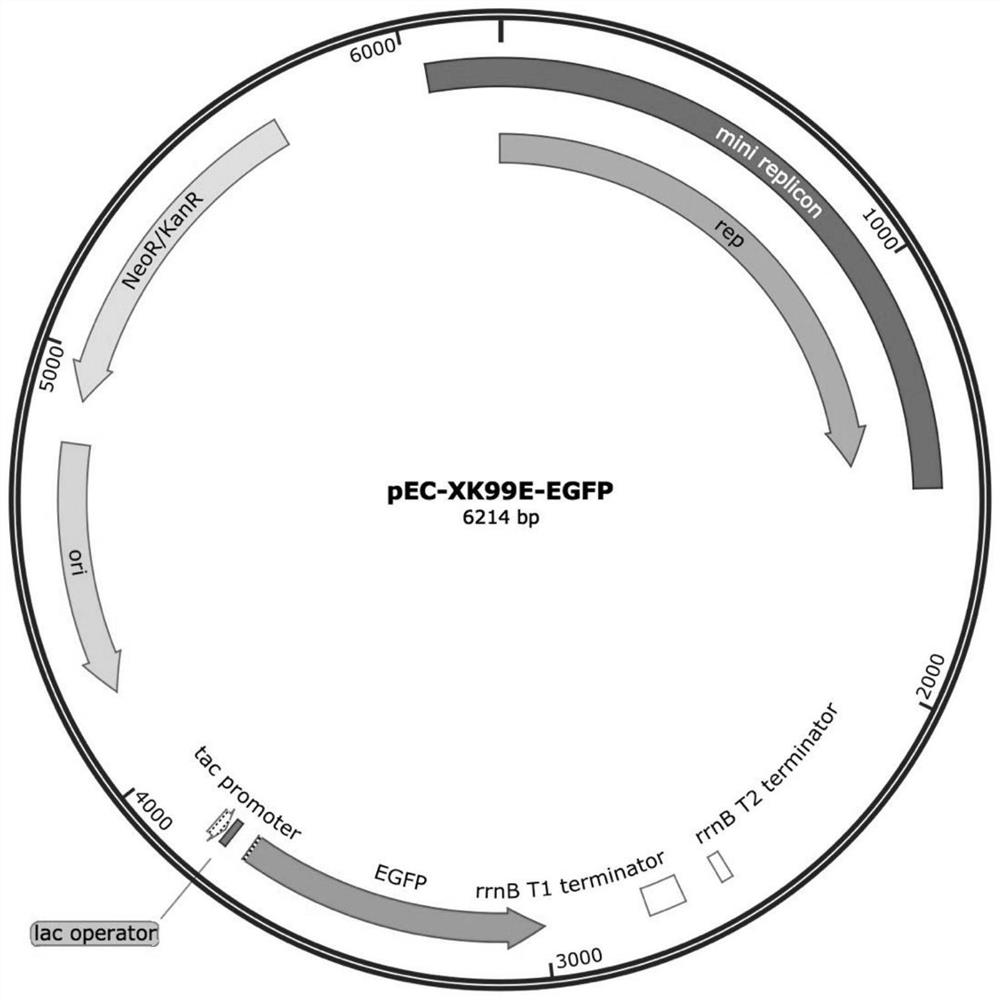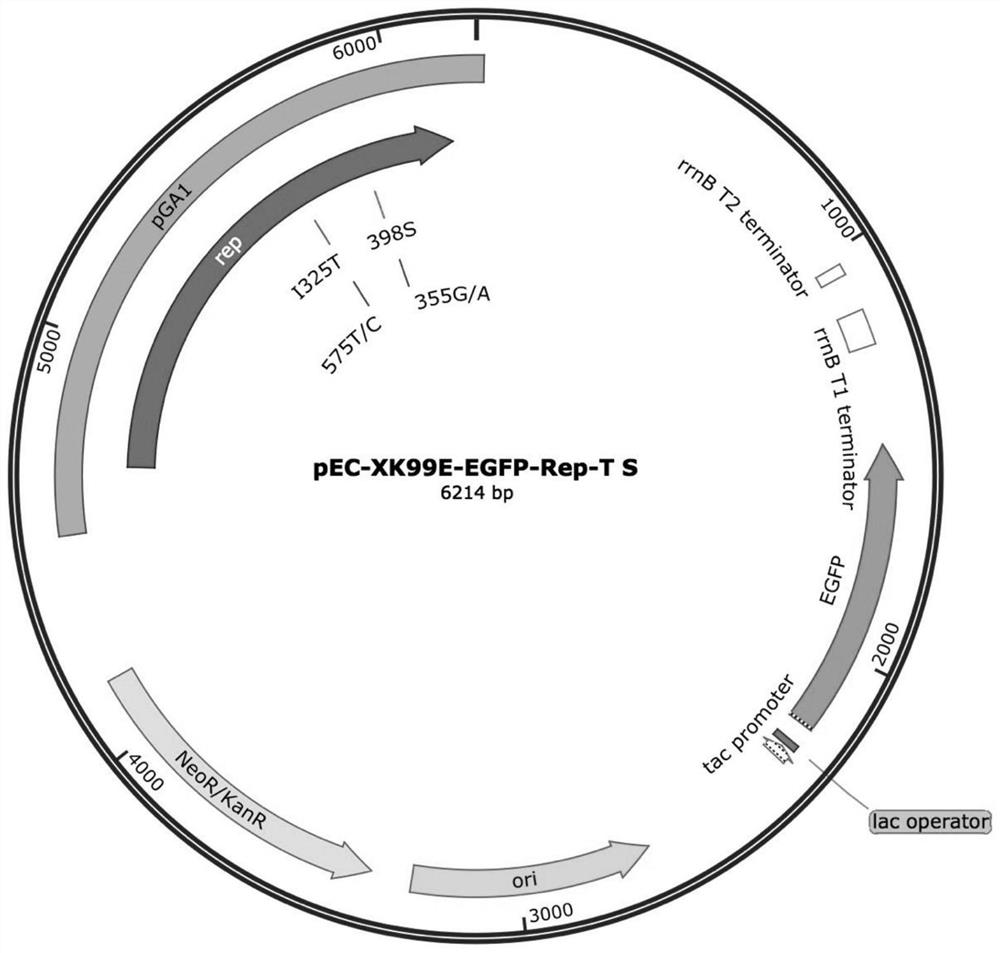Modification method of corynebacterium plasmid replicon and product of corynebacterium plasmid replicon
A technology of coryneform bacteria and replicons, applied in the field of bioengineering, can solve problems such as separation instability
- Summary
- Abstract
- Description
- Claims
- Application Information
AI Technical Summary
Problems solved by technology
Method used
Image
Examples
Embodiment 1
[0043] In vitro transformation of pGA1 Corynebacterium replicons:
[0044] The purpose of this experiment was to obtain a high copy pGA1-Rep-I325S / T398 mutant. The steps are as follows:
[0045] (1) Using the plasmid pEC-XK99E as a template, design primers, obtain the Corynebacterium pGA1 minimal replicon region (1696bp) in the pEC-XK99E plasmid by PCR, i.e. fragment 1, the primers are Replicon_F, Replicon_R and their nucleotide sequences They are shown in sequence as SEQ ID NO.3 and SEQ ID NO.4. Synthesized by Suzhou Jinweizhi Biotechnology Co., Ltd. The PCR reaction conditions were: pre-denaturation at 94°C for 3 min; denaturation at 94°C for 30 s, annealing temperature at 55°C for 30 s, extension temperature at 72°C for 2 min, for 34 cycles; and finally at 72°C for 5 min. The PCR reaction system is shown in Table 1.
[0046] Table 1 PCR reaction system
[0047]
[0048] The product after PCR amplification is subjected to agarose gel electrophoresis, and the agarose ...
Embodiment 2
[0055] Plasmid construction with mutant Rep gene:
[0056] In order to better detect product performance, the present embodiment provides the construction of a plasmid constitutively expressing EGFP protein pEC-XK99E-Rep-T / S, including the following steps:
[0057] (1) Based on the pEC-XK99E plasmid, the original genes of the lacIq promoter, lacI, and lac operon were excised to construct pEC-XK99E-Ptac containing the constitutive tac promoter.
[0058] (2) Amplify EGFP, fragment 7, using primers EcoRI-EGFP_F and BamHI-EGFP_R. The amplification method is PCR using PrimeSTAR polymerase reaction, and the reaction conditions are: pre-denaturation at 98°C for 3 min; denaturation at 98°C for 15s, annealing temperature at 55°C for 15s, extension temperature at 72°C for 1 min, and carry out 30 cycles; the final 72°C reaction is performed for 30 cycles. Hold for 5min.
[0059] (3) Double-enzyme cleavage of fragment 7 through the restriction sites EcoRI and BamHI, first add the enzyme...
Embodiment 3
[0073] Copy ability test of plasmid pEC-XK99E-EGFP-Rep-T / S in Corynebacterium glutamicum:
[0074] Take the pEC-XK99E-EGFP and pEC-XK99E-EGFP-Rep-T / S plasmids and transfer them into the wild-type strain of Corynebacterium glutamicum BZH001 respectively. The steps are as follows: (1) Take 5 μl of pEC-XK99E-EGFP and pEC-XK99E -EGFP-Rep-T / S plasmid was added to 100 μl of Corynebacterium glutamicum BZH001 competent cells, ice bathed for 10 minutes, and then transferred to a frozen electroporation cup; (2) 1800Kv electric shock twice; (3) Immediately add preheated In LBHIS recovery medium at 46℃, water bath at 46℃ for 6min, transfer to 30℃ shaker for recovery culture for 2h; (4) Spread on LBHIS solid medium with 30μg / ml kanamycin resistance, at 30℃ 24h in the incubator.
[0075] Detect the fluorescence value of the strain to reflect the copy number, and the steps are as follows:
[0076] (1) When the initial OD was set to 0.2, the bacteria of Corynebacterium glutamicum BZH001 con...
PUM
 Login to View More
Login to View More Abstract
Description
Claims
Application Information
 Login to View More
Login to View More - R&D
- Intellectual Property
- Life Sciences
- Materials
- Tech Scout
- Unparalleled Data Quality
- Higher Quality Content
- 60% Fewer Hallucinations
Browse by: Latest US Patents, China's latest patents, Technical Efficacy Thesaurus, Application Domain, Technology Topic, Popular Technical Reports.
© 2025 PatSnap. All rights reserved.Legal|Privacy policy|Modern Slavery Act Transparency Statement|Sitemap|About US| Contact US: help@patsnap.com



